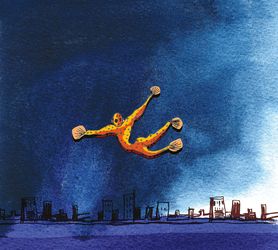When it snowed in Shimla, Delhi used to catch a cold. That was in the olden days. These days, when a farmer in Ferozepur lights a fire, Delhi breathes hard.
In the olden days, we gauged the day in fahrenheit and centigrade. These days we gauge the day in suspended particulate matter.
In the olden days, we in Delhi decided whether to sweat or to shiver after reading the weather column in the morning paper. These days, we decide to breathe easy or breathe fire at our neighbours, after checking the air quality index in newspapers and television news.
In the olden days, we talked about the weather to start polite conversations. These days, we talk about the smog to breathe fire at the farmers in Faridkot and factories in Faridabad.
Delhi had always put the blame for its discomforts at others’ doorsteps—the snow in Shimla for the cold, the weirs in Haryana for the Yamuna floods, the fires in Faridkot for the foul air in autumn. So it was this autumn, too.
The whole of Delhi—right from the judicial courts and green tribunals to pollution control boards and NGO busybodies—was cursing the farm fires in Punjab for fouling up the November air over Delhi. Arvind Kejriwal, who used to join the chorus till last year, was restrained this autumn; his party is ruling Punjab now. Indeed, they all conceded that Delhi’s crore and more cars were also to blame, but the worst curses were reserved for the farmers who had triggered the November air crisis.
Isn’t the stinking shoe on the other foot? Isn’t Delhi fouling up the air over Haryana, Punjab and UP, and not the other way round? With all the smoke that a million and more farmers are emitting from their stubble-burnt farms, there is much cleaner air over most of Punjab and Haryana. Drive up the Grand Trunk Road from Amritsar towards Delhi, and you will notice the air gets fouler as you get closer to Delhi. Don’t take my word; ask anyone in those two states, or anyone in their pollution control boards. Their views hardly get printed or their voices hardly get heard.
Who taught the farmers bad habits? They had been harvesting with hand, which left shorter stubble that rotted easily. But machine-cutting, taught to them by Delhi's green revolutionaries, leaves taller stubble, which doesn't rot before the next crop. There are machines to pluck them out, but they cost more money than what the crops can fetch.
Delhi’s own scientific studies are now calling the bluff. A real-time source apportionment study, run by the Indian Institute of Technology (IIT) Kanpur, Delhi, and The Energy and Resources Institute (TERI), show that between November 9 and 25, auto smoke contributed 30 per cent to particle pollution, secondary aerosols another 30.88 per cent and biomass burning 27 per cent. Earlier in September, when farmers weren’t burning stubble, our cars, scooters and buses contributed to 35.66 per cent.
Simply put, throughout the year, we gleefully drive our cars and scooters and foul up the air. The farmers do it on any one day in a year; yet we wield the big stick on them.
If Delhi has a right to breathe free, Delhizens ought to do their bit to keep the air clean. We run more cars and scooters on our grand avenues than all the cars and scooters of Mumbai, Chennai and Kolkata put together. We emit more particulate matter than at least two of those metros put together. We have India's largest metro network, but more of us drive to work than do New Yorkers. We don’t car-pool or pillion-pool; our buses run with vacant seats; but our roads get clogged with cars. When the air gets foul in autumn, we blame the neighbours.
prasannan@theweek.in


